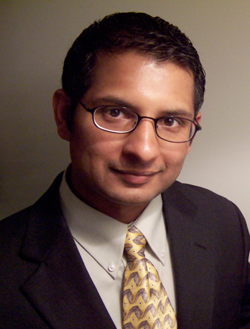Assistant Professor
Department of Biological Sciences
University of Delaware
236 Wolf Hall
Newark, DE 19716
Email: salil@udel.edu
Phone: (617) 959-9193
Fax: (302) 831-2281
Ph.D., Biology, University of Iowa, Iowa City, IA, 2003
M.Sc., Microbiology, University of Pune, Pune, India, 1996
B.Sc., Microbiology, University of Pune, Pune, India, 1994

My laboratory studies gene regulation during fiber cell differentiation in the vertebrate lens – a transparent ocular component that focuses light on the retina for visual acuity. Lens transparency is the outcome of a specialized differentiation program that occurs throughout our life and in which proliferating epithelial cells – that represent a lens stem cell-like reservoir – differentiate into elongated fiber cells that express high levels of structural and membrane proteins. Perturbation of this differentiation program results in either childhood- or age-associated opacification of the lens – clinically termed cataract. Cataract is the leading cause of blindness, accounting for ~50% of blind individuals worldwide, for which surgery is currently the only viable treatment. However, it is expensive – estimated costs in the U.S. alone are over $3.4 billion annually – and carries the risk of inducing secondary cataracts and affecting other ocular functions. Therefore, strategies to prevent or delay the onset of this disease, or those based on the therapeutic potential of regenerative medicine need to be devised – which depend on the comprehensive understanding of this tissue.
We have developed a systems-based approach termed iSyTE (integrated Systems Tool for Eye gene discovery) that is highly effective in identification of genes associated with lens development and cataract. We recently used iSyTE to identify a new gene TDRD7 associated with cataract in chick, mouse and human (Lachke et al. 2011 Science, 331:1571-76). Functional disruption of TDRD7, which encodes an RNA granule (RG) component, also results in glaucoma in mouse and human, indicative of its potential function in multiple components of the eye. RGs are ribonucleoprotein (RNP) complexes found in the cytoplasm of eukaryotic cells that are implicated in the regulation of various aspects of mRNA control, including its stabilization, degradation, or localization within the cell. Our studies show that TDRD7 interacts with other distinct classes of RGs, namely Processing bodies (PBs) and STAU1 RNPs to regulate critical lens-expressed mRNAs. Our current experiments are focused at understanding the RG-based post-transcriptional regulatory mechanism in fiber cell differentiation. Specifically, we aim to: (1) Characterize the cataract phenotype in theTdrd7 null mouse mutant, (2) Identify TDRD7-interacting proteins and mRNAs in the lens, and (3) Test new iSyTE-predicted RG component proteins and their function in the lens. Because fiber cells share several RG-dependent features with other cells in the body – for example, they are elongated like neurons, become transcriptionally inactive like differentiating sperm, and are polarized like migrating fibroblasts – our studies are expected to provide insight into the control of gene regulation in cellular differentiation and its associated diseases.
Dr. Lachke completed his B.Sc. and M.Sc. in Microbiology at the University of Pune, India, where his Masters’ research focused on isolation of thermophilic bacterial species producing industrially important enzymes. He then worked for a year at the National Chemical Laboratory in India on the biochemical characterization of yeast-mycelium transition in fungi before joining Dr. David Soll’s laboratory at the University of Iowa to pursue doctoral studies on the molecular basis of phenotypic switching, mating and filamentation in pathogens Candida albicans and Candida glabrata. His doctoral thesis received the D.C. Spriestersbach dissertation Prize – presented every other year to excellence in biological research at the University. Dr. Lachke then undertook post-doctoral research in Dr. Richard Maas’ laboratory at Harvard Medical School and Brigham & Women’s Hospital in Boston where he developed systems-based approaches to study mammalian ocular development and disease. Dr. Lachke’s post-doctoral research has been published inScience magazine and has won several awards, notably, the American Society of Human Genetics’ Trainee Award for Post-doctoral Clinical Research, the BWH Biomedical Research Institute’s Research Excellence Award for Innovative Research, and the Bettelheim Young Investigator Award for Excellence in Cataract Research from the International Society of Eye Research. Dr. Lachke served as an Instructor in Medicine at Harvard Medical School and lectured in Harvard School of Dental Medicine before joining the faculty at the University of Delaware in 2011.